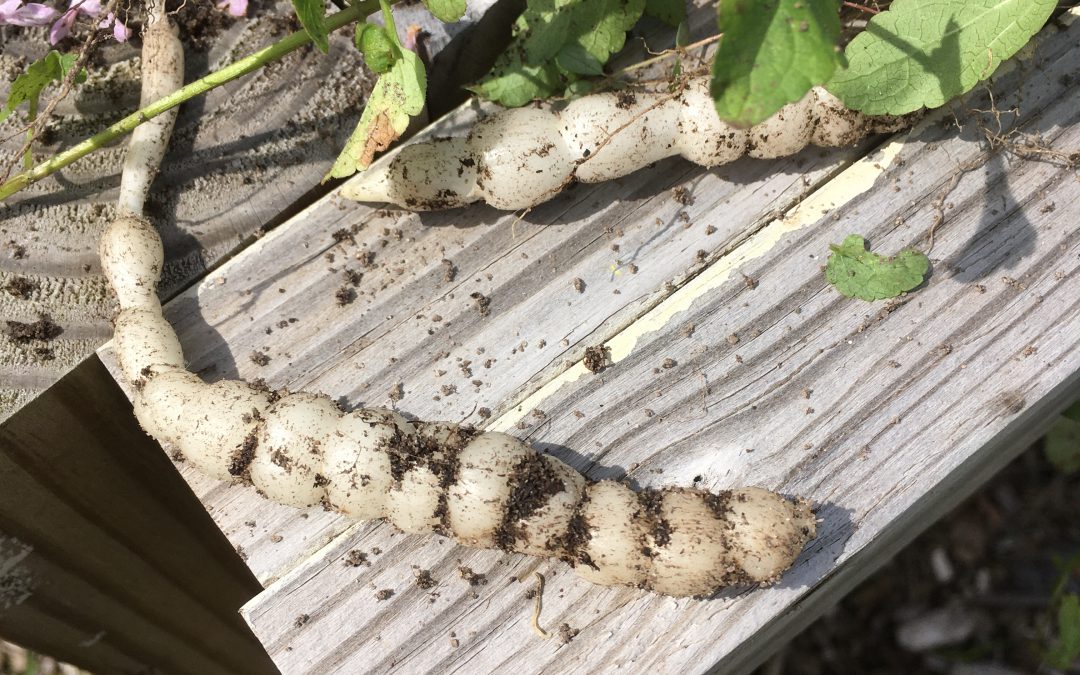
by Julie McConnell | Jun 11, 2020
Why are the plants we are trying not to grow so hard to kill? Weeds can be quite frustrating to home gardeners as they struggle to get them under control. There are a few things you can do to help make your efforts more successful.
Identify the weed. It might seem like it doesn’t matter what the plant is if you know you want to get rid of it, but a big part of your strategy should be figuring out why that plant is being so difficult. Below are the reasons why weed identification is so critical in your fight to control it.
- Which plant are you favoring with your maintenance routine? All plants have similar basic needs: water, sunlight, nutrients, and a space to grow, but some perform better with varying amounts of each of these inputs. Sometimes we can influence these factors in a way that favors one plant over another. The best example is how we irrigate our landscape. If you plant drought tolerant shrubs, such as Indian Hawthorne, which can survive with little to no irrigation after establishment, and then continue to water 2-3 times a week, is it any wonder that you get water loving weeds such as dollarweed, torpedograss, or sedge? Only apply inputs that support your desirable plants and nothing more.
- Recognize the weed type. There are three main types of weeds we typically encounter: broadleaf, grass, or sedge. Some herbicides are broad-spectrum, which means they kill any type of plant, while others are selective. Selective herbicides generally target either broadleaf, grass or sedge weeds and have minimal impact on the other types. This can be very important information to have if you are shopping for an herbicide.
- Understand the life cycle. Herbaceous plants fall into three main life cycle categories: annual, perennial, or biennial. Annuals and biennials tend to reproduce primarily from seed. The annual plant completes its entire life cycle in one season or year and a biennial takes two years. When targeting these two, your goal is to get rid of the plant before it flowers and sets seed to reduce future crops. If you miss that window and the weeds go to seed, plan to use a pre-emergent herbicide prior to their next scheduled germination date (usually the next season). Perennials live for more than 2 years and tend to be tough to manage. They may reproduce by seed but many also multiply by vegetative means. To put this simply, they store everything they need in tiny pieces of the plant and if left in place, it will generate more plants. So, that little tiny root fragment from dollar weed you didn’t pull up – yep, it’ll grow a whole new one in its place!
For more information on weeds and weed control in lawns and landscapes, contact your local UF/IFAS County Extension Office!
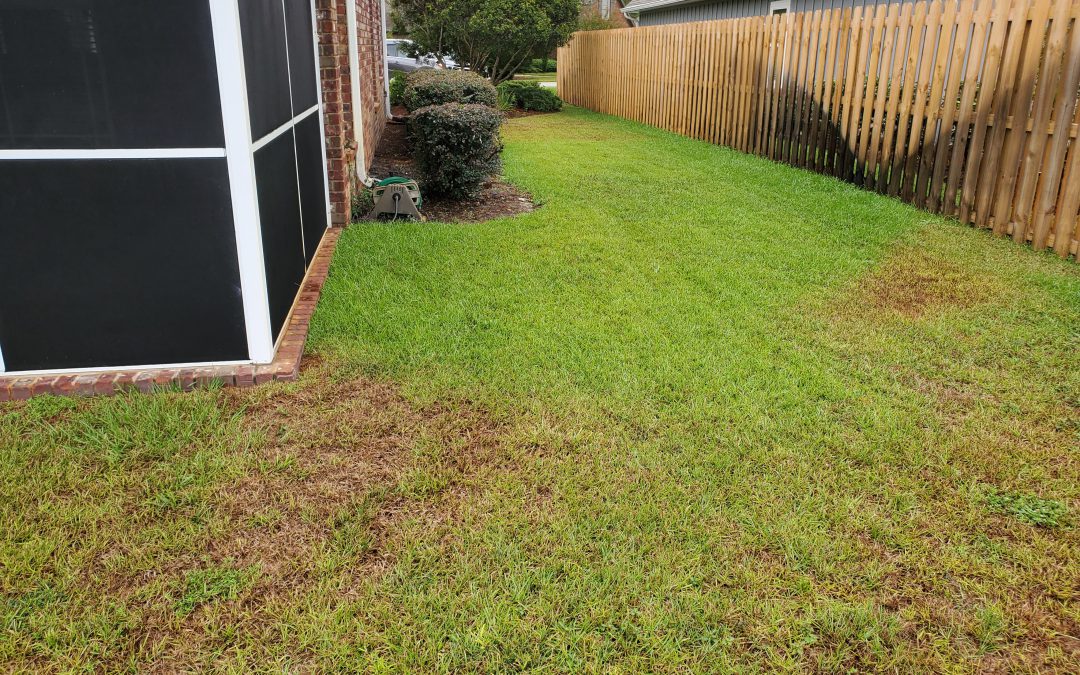
by Evan Anderson | May 13, 2020
As temperatures lean more toward summertime highs, conditions can sometimes leave a landscape looking sad. Water issues can be a major source of headaches for homeowners when they cause plants to decline. The cause is not always readily apparent.
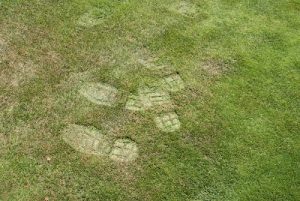
Footprints remain in droughty grass. Photo courtesy of Taylor Vandiver.
Water is something not even the meanest cactus in the driest desert can do without. Too little, and plants start to develop symptoms of drought stress. These symptoms include more than just wilting; stunted growth, curling or rolling leaves, fruit or leaves dropping, and yellowing or browning especially at leaf edges are all clues that a plant is thirsty. In lawns, underwatered grass may not spring back when stepped upon, leaving visible footprints in the turf. Long periods of drought stress can cause grass to thin. Plants exhibiting symptoms such as these may require extra water. A layer of mulch around landscaping can also help to retain moisture if soil dries out too quickly. Newly installed plants are particularly susceptible to drying out, and hot weather dries out all plants more quickly.
Plants can also be overwatered, however. Even with the well-drained, sandy soils that are present in much of the Florida Panhandle, it is possible to put too much water on a lawn or landscape. This can lead to problems that may be similar to those caused by underwatering – stunted growth, curled leaves, wilting, limbs or leaves dying, and increases in fungal disease can all occur. Lawns may become patchy and weeds, especially those that enjoy damp conditions such as sedges or dollarweed may establish themselves.
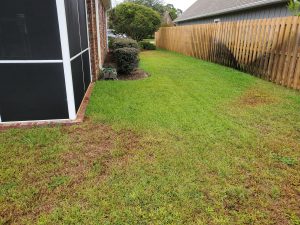
Improperly calibrated sprinklers. Photo courtesy of Evan Anderson.
Stress of any sort can also leave plants more susceptible to pest and disease issues. A healthy plant is better able to compete with weeds and fight off infestation or infection. If you notice problems with fungal disease, increased insect populations, or weed issues, it could be made worse by over- or underwatering!
To help avoid watering issues, make sure plants with similar water requirements are planted near one another. If you have irrigation for your lawn or landscape, it is important to calibrate it regularly. Make sure the system has a rainfall shutoff device and check systems for damaged or malfunctioning emitters. And remember, if you are having trouble with your lawn or landscape, contact your local Extension office for help!
You can find further information on watering in our EDIS publications located at https://edis.ifas.ufl.edu/topic_landscape_irrigation_and_fertilization, and at our Gardening Solutions website at https://gardeningsolutions.ifas.ufl.edu/care/irrigation/.

by Larry Williams | Apr 29, 2020
In times like these, it seems that our own perceived “problems” pale in comparison to the “big picture.” In my day-to-day work, I have the opportunity to help people solve problems with their landscapes, lawns and gardens. I enjoy the problem solving part of my job as an extension agent.
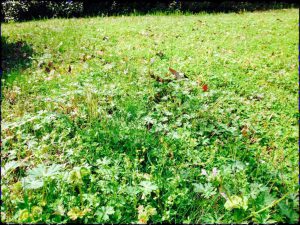
Winter annual weeds in lawn in early spring. Photo credit: Larry Williams
You’d be surprised how upset some people can be about a few weeds, a dying petunia or a tomato with a crack in it. They’ll let small things like this upset their entire world. It’s as if they think we live in a perfect world when it comes to expectations for the plants in their own landscape.
It has become apparent to me that too many people spend too much time letting too many small things bother them too much.
When my twin sister, Linda, and I were growing up in a small town in middle Georgia, an elderly couple (Mr. and Mrs. Hunt) would crack pecans and give the shelled halves to us to eat. They’d hand the shelled pecans to us over the fence that separated our yards. At five or six years old this was a treat for my sister and me.
I remember their landscape. I remember Mrs. Hunt sweeping their dirt driveway lined with coconut sized rocks. She used handmade brooms. I remember their pink flowering dogwoods in spring. I remember their old-fashioned yellow and orange daylilies during summer. I remember the fascination of seeing red spider lilies seemingly come from nowhere in the fall underneath deciduous trees as they displayed their autumn colors. I remember Mrs. Hunt letting me smell a flower from a sweetshrub plant, which reminded me of sweet apples. The deep red blooms and dark green leaves of this shrub complemented the white wooden wall on the east side of their home.
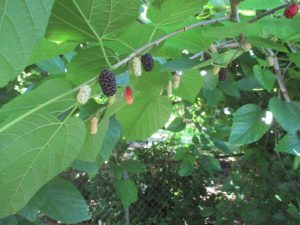
Mulberry tree with fruit. Photo credit: Larry Williams
I remember climbing a large mulberry tree in their backyard and picking and eating the berries. I remember watching Mr. Hunt prune grapevines growing on an overhead trellis. I remember learning about the history of a ginkgo tree planted just outside a chicken pin in their side yard. I remember watching hummingbirds flying in and out of the reddish orange funnel-shaped blooms of a large trumpet vine growing on an old metal frame of a water tank.
I don’t remember the weeds, even though I know there must have been weeds in the Hunt’s landscape. I know there was the occasional pecan that didn’t fill out or that was worm infested. And I’m sure an occasional plant had to be replaced. But these are not the things that made lasting impressions for me.
The big picture is not the weeds, the dying petunia plant or the pecan with a worm in it. Sure you will have weeds in your yard and certain plants that don’t survive. Just don’t let these things become the source of worry. In my opinion, a landscape should be a source of pleasure, a place to learn and a place to pass along lasting memories. Besides, with all the things there are to worry about in this world (as recent days have revealed), why let your own backyard be one of them?
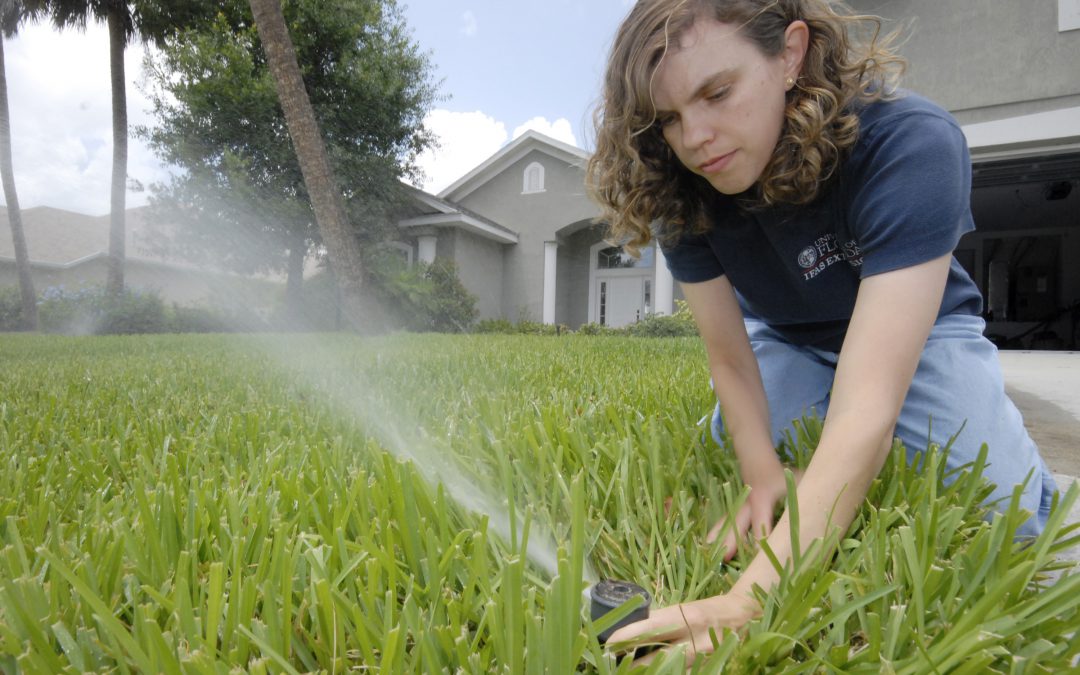
by Mary Salinas | Apr 1, 2020
With our warm weather, many homeowners are looking to create a beautiful lawn for the year. There are so many products in the home improvement stores and nurseries that promise to make your lawn into a green paradise. What to choose?
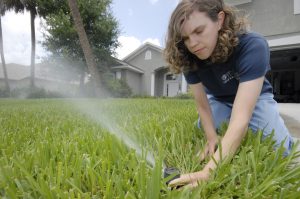
Photo UF/IFAS Extension. Spring is a good time to check the water flow and direction of a pop-up irrigation system and make adjustments as necessary.
UF/IFAS Extension provides advice based on scientific research. This is what the science says:
- Wait to apply lawn fertilizer in north Florida until mid-April. Lawn grasses don’t have sufficient root growth and capabilities to use the fertilizer until then. Applying fertilizer earlier in February and March feeds the winter weeds or is lost to leaching down into the soil below the grass roots. Here’s more detail on fertilizing your lawn.
- Weed and feed products are not recommended. Instead, spot treat weeds when they are small before they mature and set seed. Consult our Weed Management Guide.
- Preemergence herbicide, if applied correctly, can cut down on the weeds. Apply in late February or first of March for summer weeds and October 1 for winter weeds. Now in late March – Early April is still a good time to use a preemergence herbicide for those weeds that have not yet sprouted. It is crucial to apply the product correctly, following all label directions. Measure your lawn and make sure the right amount of product is applied. This is a convenient way to measure your lawn from your armchair.
- Sharpen your mower blades! A clean cut on the grass blade cuts down on lawn stress and diseases setting in.
- Water efficiently. We see more damage to lawns from overwatering than underwatering. Overwatering leads to increased weeds, disease, insect pests and weakens grass roots. Lawns need ½” to ¾“ of water and this will tell you how to determine when to water. The root system is healthier and stronger when watered deeply only when it needs it. Learn how long it takes your sprinkler system to deliver that amount.
The University of Florida provides more advice and information at:

by Larry Williams | Dec 4, 2019
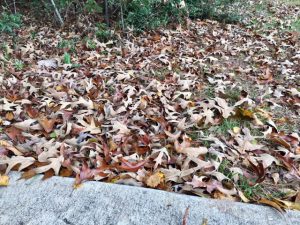
Fall oak tree leaves abound and can be recycled as landscape mulch. Photo credit: Larry Williams
Weed control is not top on my list as a reason to use mulch. There are weeds that can push through mulch such as nutsedge (nutgrass) or that can germinate and grow in the mulch. But done correctly, mulching plant beds and gardens can help inhibit some weeds. Tree leaves can be used as a mulch.
In addition to weed control, mulch provides other benefits. It can make landscapes look more attractive. It keeps roots evenly moist, acts to insulate roots from extreme heat and cold and can help decrease loss of soil from wind and water erosion. Mulch serves as a barrier to some soil-borne diseases, especially in the vegetable garden. And, as organic mulch breaks down, it improves the soil’s fertility, aeration, structure and drainage.
Tree leaves make good mulch. They can be placed on the soil surface beneath and around shrubs, trees, perennials, annuals and vegetables.
Fall leaves are abundant. Some people feel overwhelmed by the volume. One resident reported raking more than 100 large bags of leaves from his half-acre property. One large oak tree can contain over 250,000 leaves!
Tree leaves can be placed in landscape beds or around vegetables “as is” or chopped up with a shredder or mower into smaller pieces and then spread around vegetables, shrubs and trees. Mixing leaves from several different species of trees can make better leaf mulch. Leaves of the same size tend to mat together and produce a shingling effect that can shed water and reduce gas exchange in the soil. Shredded leaves stay seated better on the landscape than whole leaves.
A mulch layer three inches deep after settling is enough for most plants. If possible, extend the mulched areas out to the outermost leaves (called the drip line) and beyond. And be sure to pull the mulch back a few inches from the main trunk. Never pile mulch around the trunk.
Using those fallen tree leaves as mulch recycles a natural resource and saves you money, enriches your soil, fertilizes your plants and keeps them out of the local landfill.
So, instead of putting all those leaves curbside in plastic bags to be hauled off, use them to benefit your landscape, which may include less weeds.
For additional information on landscape/garden mulch, contact the UF/IFAS Extension Office in your County or access the following sites.
http://gardeningsolutions.ifas.ufl.edu/care/planting/mulch.html
http://edis.ifas.ufl.edu/topic_mulch
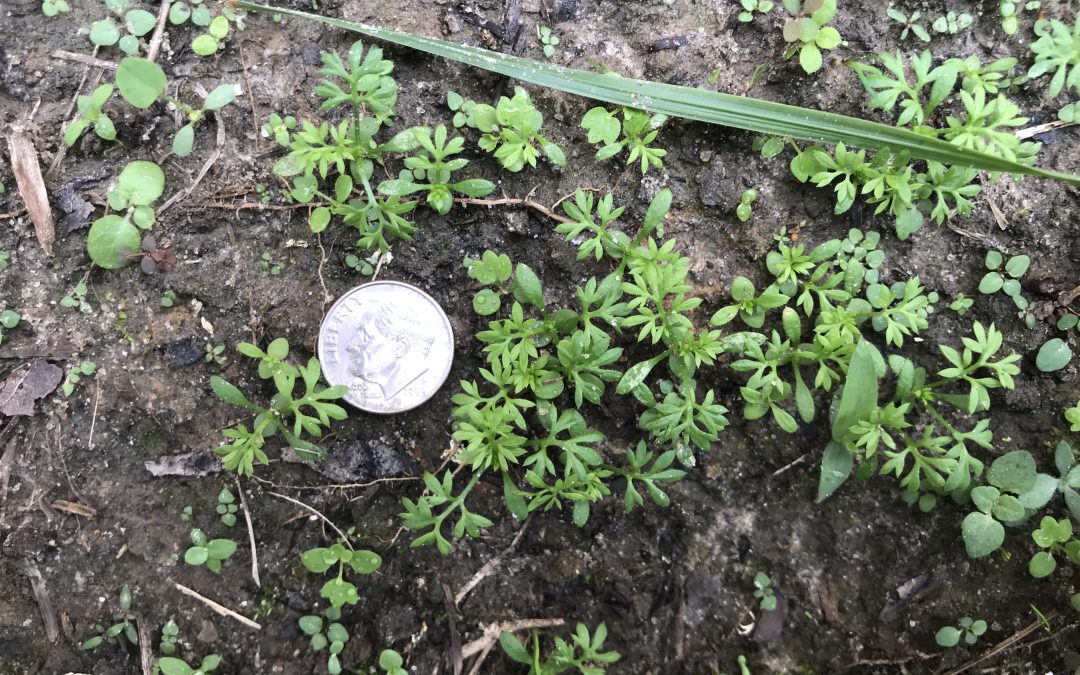
by Daniel J. Leonard | Nov 8, 2019
Most lawn weeds are annoying, appearing in unwanted places and numbers, but few actually cause physical harm like the pest plant Lawn Burweed (Soliva sessilis)! This infamous small, spreading winter weed’s seeds generally germinate when temperatures begin to cool in the fall (late October-November). Burweed then grows mostly unnoticed through the winter until spring, when it then produces the hard, spiny burs that contain the plant’s seeds and the plants finally die. Once the burs have formed, Burweed’s presence makes walking on newly greened-up spring turf extremely painful for pets and people (barefoot of course, the burs aren’t large enough to puncture shoe soles). At this point of the plant’s life, once it has made its unwanted presence known, control is not feasible as the Burweed plants have set seed, ensuring a new crop next year, and killing the remaining foliage doesn’t remove the burs. What is a homeowner to do?
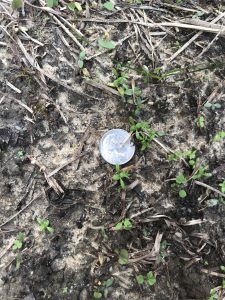
Newly germinated Lawn Burweed. Photo courtesy of the author.
Fortunately, Lawn Burweed is relatively easy to control chemically if one pays close attention to seasonal changes and uses herbicides (either pre-emergent or post-emergent herbicides) effectively.
Pre-emergent Herbicide Options: The first chemical control option for Lawn Burweed is a timely application of the pre-emergent herbicide Isoxaben (sold under various brand names at most farm or garden stores) to prevent Burweed seeds from germinating, greatly reducing plant populations. However, pre-emergent Isoxaben applications must be made before the plants sprout and begin to grow to be effective. For Burweed, this generally means application in October, once nighttime temperatures dip into the 55-60 degrees F range for several nights in a row, as consistent temperatures in this range give Burweed seeds the signal to germinate. Though we’re already past the point of pre-emergent herbicides being an option for control this year, homeowners should plan to include this method in their Lawn Burweed control plan for fall 2020!
Post-Emergent Herbicide Options: If you haven’t already used a pre-emergent herbicide this fall for Burweed control, you must turn to post-emergent options. Like pre-emergent herbicides, timing is critical if you want your post-emergent applications to work! These herbicides are most effective when Burweed plants are young, small, vigorously growing, and haven’t set burs yet. Successful post-emergent applications may be made from December-early February before burs harden. Unlike pre-emergents, where there is only one strong option for Burweed control, many post-emergent herbicides exist that are extremely effective! When shopping, look for products containing the following active ingredients:
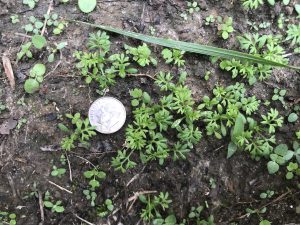
Lawn Burweed around 10 days after emergence. Photo courtesy of author.
- Atrazine – sold under many brand names and safe in Centipede, St. Augustine, & Bermudagrass. Do not use in Zoysia or Bahiagrass lawns.
- Dicamba, Mecoprop, 2,4-D – commonly sold in three-way formulations through many brand names. Generally safe in Centipede, St. Augustine, Bermuda, Zoysia, & Bahiagrass lawns.
- Metsulfuron – sold under several brand names and safe in Centipede, St. Augustine, Zoysia & Bermudagrass. Do not use in Bahiagrass. Be careful if used around ornamentals.
- Thiencarbazone, iodosulfuron, dicamba – sold as Celsius WG from Bayer. Safe in Centipedegrass, Zoysiagrass, Bermudagrass, and St. Augustinegrass. Do not use in Bahiagrass.
Lawn Burweed control with of all the above-listed herbicides will be most effective with a follow-up application 10-14 days later.
Note: With the exception of the Thiencarbazone, iodosulfuron & dicamba mixture (Celsius), do not apply any of these post-emergent herbicides during spring turf green up.
As always, if you have questions about Lawn Burweed control or any other horticulture or agriculture related questions, please contact your local UF/IFAS County Extension office or consult any of the following related articles: https://nwdistrict.ifas.ufl.edu/hort/2015/10/06/lawn-burweed-prevention-is-easier-than-cure/ and http://blogs.ifas.ufl.edu/washingtonco/2017/10/11/prepare-now-to-avoid-lawn-burweed-infestation-later/
Happy gardening!














